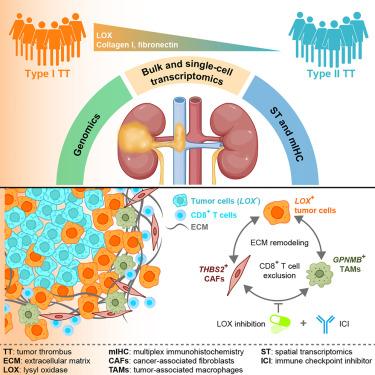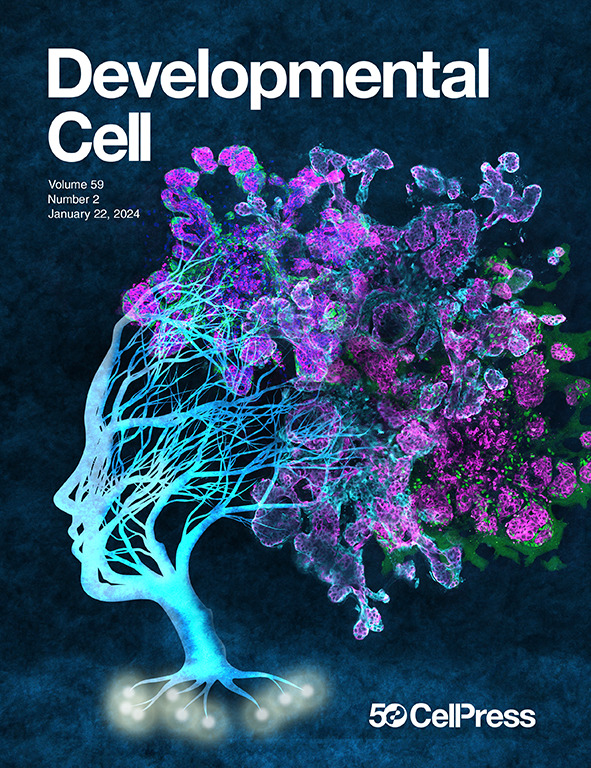细胞外基质重塑能力暴露了一类肾细胞癌伴肿瘤血栓的治疗脆弱性
IF 8.7
1区 生物学
Q1 CELL BIOLOGY
引用次数: 0
摘要
术前降低肾细胞癌伴肿瘤血栓(RCC-TT)的分期使血栓切除术成为可能。然而,治疗耐药是常见的,可能部分归因于肿瘤微环境(TME)的促肿瘤作用。在此,我们对164例RCC-TT患者的多中心、多组学数据进行了测序、整合和综合分析,并确定了两种临床相关的RCC-TT亚型。我们发现预后不良亚型(TT1)表现出由上皮LOX表达驱动的细胞外基质(ECM)重塑增强。空间转录组学(ST)显示,在TT1肿瘤中,GPNMB+巨噬细胞、THBS2+成纤维细胞和LOX+恶性细胞在肿瘤巢周围共定位,增强肿瘤免疫屏障(TIBs)。我们使用细胞系、同基因小鼠模型、多重免疫荧光染色和大规模RCC队列进行了广泛的验证,强调了LOX抑制在破坏TIBs、使RCC对免疫治疗敏感以及克服治疗诱导的表型可塑性方面的潜力。本研究为RCC-TT的生物学基础和预后评估提供了见解,展示了靶向的ecm重塑脆弱性。本文章由计算机程序翻译,如有差异,请以英文原文为准。

The extracellular-matrix-remodeling capability exposes therapeutic vulnerability in a subset of renal cell carcinomas with tumor thrombi
Preoperative downstaging of renal cell carcinoma with a tumor thrombus (RCC-TT) makes thrombectomy feasible. However, treatment resistance is common and may partly be attributed to the tumor-promoting role of the tumor microenvironment (TME). Herein, we sequenced, integrated, and comprehensively analyzed multi-center, multi-omics data from 164 RCC-TT patients and identified two clinically relevant RCC-TT subtypes. We find that the poor-prognosis subtype (TT1) exhibits enhanced extracellular-matrix (ECM) remodeling driven by epithelial LOX expression. Spatial transcriptomics (ST) shows the co-localization of GPNMB+ macrophages, THBS2+ fibroblasts, and LOX+ malignant cells around tumor nests in TT1 tumors, reinforcing tumor immune barriers (TIBs). Our extensive validations using cell lines, syngeneic mouse models, multiplex immunofluorescence staining, and large-scale RCC cohorts underscore the potential of LOX inhibition in disrupting TIBs, sensitizing RCC to immunotherapy, and overcoming treatment-induced phenotypic plasticity. This study provides insights into the biological underpinnings and prognosis assessment of RCC-TT, demonstrating targetable ECM-remodeling vulnerabilities.
求助全文
通过发布文献求助,成功后即可免费获取论文全文。
去求助
来源期刊

Developmental cell
生物-发育生物学
CiteScore
18.90
自引率
1.70%
发文量
203
审稿时长
3-6 weeks
期刊介绍:
Developmental Cell, established in 2001, is a comprehensive journal that explores a wide range of topics in cell and developmental biology. Our publication encompasses work across various disciplines within biology, with a particular emphasis on investigating the intersections between cell biology, developmental biology, and other related fields. Our primary objective is to present research conducted through a cell biological perspective, addressing the essential mechanisms governing cell function, cellular interactions, and responses to the environment. Moreover, we focus on understanding the collective behavior of cells, culminating in the formation of tissues, organs, and whole organisms, while also investigating the consequences of any malfunctions in these intricate processes.
 求助内容:
求助内容: 应助结果提醒方式:
应助结果提醒方式:


